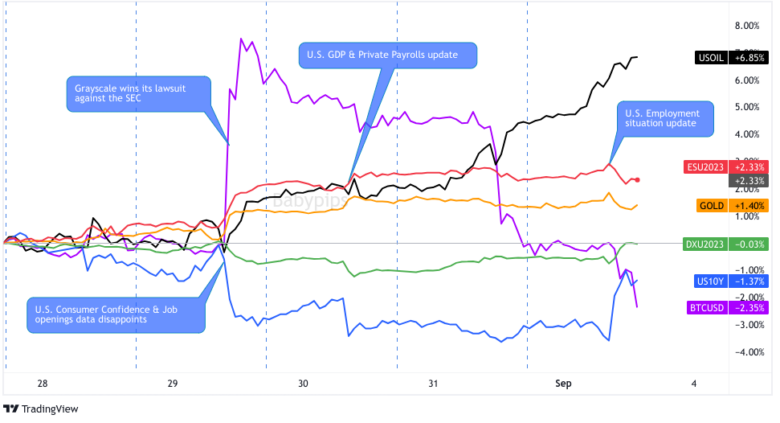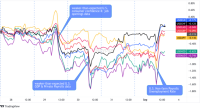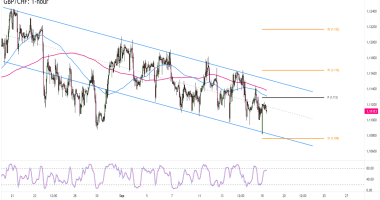After a slow start, the major financial asset classes jumped into anti-Dollar mode thanks to a heavy U.S. calendar showing signs of economic growth cracking.
This lifted prospects of the Fed nearing the end of its tightening cycle, which took down the Greenback most of the week while boosting gold and U.S. equities in the process.
So, how did the other global assets behave this week? I can explain, but lemme show you the biggest headlines first:
Notable News & Economic Updates:
🟢 Broad Market Risk-on Arguments
Australia’s retail sales rebounded by 0.5% m/m in July (vs. 0.3% expected, -0.8% previous); annual sales up by 2.1% – the lowest since August 2021
British Retail Consortium: U.K.’s annual shop price inflation cooled from 7.6% to 6.9% in August, marking its slowest price increase since October 2022
Germany’s Unemployment rate held at 2.9% in July 2023; job growth was relatively flat m/m
Australian inflation slowed from 5.4% y/y to a 17-month low of 4.9% y/y in July driven by declines in holiday travel and fuel prices
Australia’s private capital expenditure rose by 2.8% q/q in Q2 (vs. 1.1% expected, 3.7% previous) led by investment in new equipment and machinery
New Zealand business confidence lifted another 9 points to -3.7, the highest reading since mid-2021 as inflation indicators continued to ease
🔴 Broad Market Risk-off Arguments
Job Openings and Labor Turnover Survey showed open job openings decreased from 9.17M in June to 8.83M in July
ECB Governing Council member Robert Holzmann said on Monday that they likely need to raise interest rates again in September
U.K. Net mortgage approvals fell to 49.4K in July vs. 54.6K in June
The second estimate for U.S. GDP Growth for Q2 2023 came in lower at 2.1% y/y vs. 2.2% forecast; quarterly core PCE Prices Index change at 3.7% (3.8% forecast, 4.9% previous)
U.S. Core PCE Price Index for July: 0.2% as expected; Inflation-adjusted consumer spending rose by 0.6% m/m
J.P.Morgan Global Manufacturing PMI for August: 49.0 vs. 48.6 in July
U.S. Non-Farm Payrolls for August: 187K (180K forecast) and the July read revised lower to 157K from 209K; unemployment rate popped higher to 3.8% from 3.5% unexpectedly; average hourly earnings grew by +0.2% m/m (+0.4% m/m forecast/previous)
ISM U.S. Manufacturing PMI for August: 47.6 (47.0 forecast; 46.4 previous)
Global Market Weekly Recap
China started the week with a bang, as authorities announced measures to support its equities markets:
- The stamp duties on stock transactions will be cut from 0.1% to 0.05%.
- The margins required before buying stocks will be lowered.
- The pace of IPOs will be lowered due to “recent market conditions.
- Selling from top stakeholders of firms whose stock prices have fallen below IPO prices or net asset levels will be restricted.
The new measures were a bit underwhelming compared to straight up moolah assist that the markets were expecting. Plus with U.K. traders out on holiday, volatility was light and those who were around apparently stuck with risk-on vibes.
It didn’t hurt that Asian and European session traders were still pricing in Fed Chairman Powell announcing over the Jackson Hole weekend that the Fed would “proceed carefully” (read: be less hawkish) with its next policy changes.
U.S. 10-year yields saw a steady downtrend while AUD, which already found support from a strong Australian retail sales release, closed near its intraday highs.
The risk-friendly / anti-Dollar vibes gained a lot of momentum on Tuesday after the U.S. printed weak reports and traders thought, “Bad news is good news because…reasons.”
U.S. job openings fell to their lowest levels since 2021 while a separate consumer confidence release showed souring views on jobs, high borrowing costs, and sticky inflation.
But that’s alright because the “good news” is that the Fed may now have more reasons to think twice about further raising interest rates.
U.S. stocks climbed the most since June; U.S. 10-year yields plummeted from an intraweek high of 4.24% to 4.10%, and the U.S. dollar ate dust against its major counterparts.
Bitcoin even got an extra boost from the news that Grayscale Investments, a biggish crypto investment firm, won a ruling that compels the U.S. Securities and Exchange Commission to re-evaluate its process and standards for denying Grayscale’s proposal to convert its Bitcoin Trust (GBTC) into an ETF.
BTC/USD, which had been hanging around at $26,000, shot up all the way to $28,000 before profit-takers pulled it back down to $27,500 by the next trading day.
Wednesday’s price action was a little more mixed with different market movers for each trading session.
During the Asian session, BOJ board member Naoki Tamura shared that the central bank’s 2.0% inflation target was now “clearly in sight” and may be enough to turn the BOJ’s dovish biases around as soon as January through March next year. JPY made new intraweek lows across the board at the prospect!
The spotlight then shifted to Europe after Germany and Spain’s inflation reads left room for more ECB rate hikes. EUR made new intraweek highs while GBP also made slow and steady gains throughout the day.
The “bad news is good news” buzzword lost some of its shine during the U.S. session after data showed that the U.S. economy made less progress in Q2 than initially estimated while the ADP report pointed to a moderating rate of employment growth.
U.S. equities still continued their bullish runs, but this time “risky” comdolls like AUD and NZD easily lost their U.S. session gains and the U.S. dollar recovered from its fresh intraday lows.
A couple of reports on Thursday accelerated the selling especially for the European currencies. While France’s CPI rate still supported an ECB rate hike, misses in German retail sales and French consumer spending reminded traders that higher interest rates are NOT a good thing for growth.
It didn’t help that ECB members Isabel Schnabel and Luis De Guindos shared hawkish remarks in their interviews.
EUR, GBP, and even CHF saw steady-ish downswings throughout the day. BTC/USD also saw some selling as it dropped from its $27,500 highs back down to its $25,800 pre-Grayscale headline levels. FOMO NO MO!
U.S. crude oil prices missed the memo and extended its intraweek uptrend. And why not? Aside from receiving support from a possibly less hawkish Fed earlier in the week, Russia’s Deputy Prime Minister Alexander Novak egged on crude oil bulls on Thursday by sharing that Russia has agreed on further OPEC+ export cuts but will drop the deets next week.
USOIL, which just hit an intraweek low of $79.50 on Tuesday, extended a bullish breakout that took the commodity to the $83.50 territory.
Broad market volatility collectively quieted down at the start of Friday’s session as traders awaited the highly anticipated U.S. employment situation update. And once again, the event didn’t disappoint as the net change came in better-than-expected, but the unemployment rate jumped from 3.5% to 3.8%.
Average hourly earnings was a miss at 0.2% m/m, and when all put together, was arguably net bearish for the Greenback. But that sentiment didn’t last too long as the markets got the latest ISM Manufacturing PMI read for August, and while it continues to signal contractionary conditions, it did come in better than both expectations and the previous read.
This sparked a mixed reaction across the major assets with the Greenback, bond yields and oil shooting higher, arguably on the idea that the soft landing / less hawkish Fed scenario is still ahead. Apparently, this was enough to get the U.S. dollar index to barely creep back in the green to join the rest of the major asset classes in positive territory into the weekend.
This post first appeared on babypips.com










